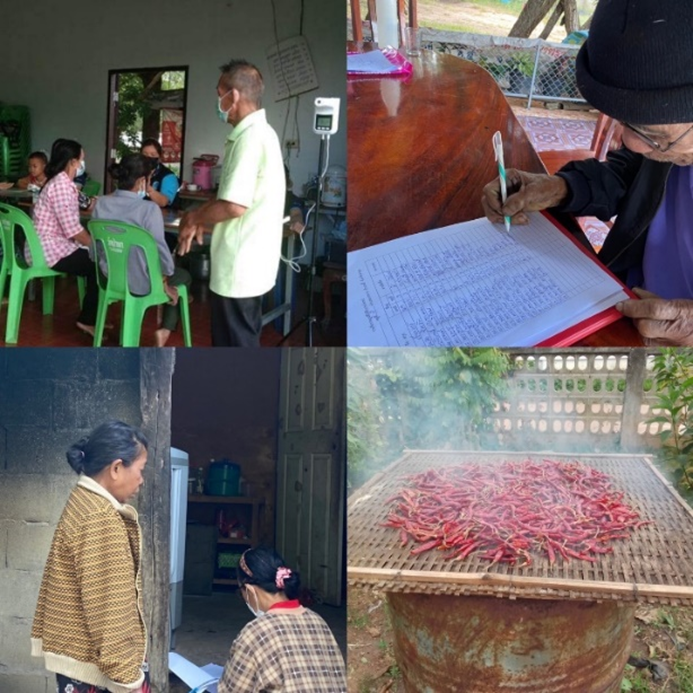Evaluation of the Population's Health Risk from Aflatoxin in Dried Chillies in Ban Palad Community, Li City, Lamphun Province, Thailand
คำสำคัญ:
Aflatoxin, Risk assessment, Exposure, Risk Ranger programบทคัดย่อ
The occurrence of aflatoxin, a potent carcinogenic toxin produced by the fungi Aspergillus flavus and Aspergillus parasiticus, in food is a significant public health concern worldwide. Dried chilli is among the most commonly contaminated food items, particularly in tropical and subtropical regions. In Thailand, the consumption of dried chilli is prevalent, and its contamination with aflatoxin has been reported in several regions. One such region is Ban Palad community, located in Li City, Lamphun Province, where the majority of the population relies on agriculture and small-scale food processing for their livelihoods. Despite the potential health risks of aflatoxin exposure through contaminated chilli consumption, no studies have been conducted to assess the exposure and health risks in this community. Therefore, the present study aimed to assess the levels of aflatoxin contamination in dried chilli consumed by the population in Ban Palad community and to estimate the associated health risks. The results of the survey showed that 52% of respondents and 48% of respondents, respectively, had known and unknown mycotoxins. There were 84.67% and 15.33%, respectively, of people who were aware that dried chilli can develop mold when maintained in a moist or humid environment under known and unknowing factors. The percentage of individuals known to have liver cancer caused by the mycotoxin in dried chilli peppers was 16.67% and 83.33%, respectively. This study's findings will provide valuable information for policy-makers and local communities to develop strategies to reduce aflatoxin contamination and mitigate the associated health risks. In conclusion, the risk assessment of aflatoxin in dried chilli from Risk Ranger program indicates that there is a moderate level of risk associated with consumption. Consumers should be aware of the potential hazards and take necessary precautions to reduce the risk of exposure.
เอกสารอ้างอิง
Azziz-Baumgartner, E., Lindblade, K., Gieseker, K., Rogers, H. S., Kieszak, S., Njapau, H., Schleicher, R., McCoy, L. F., Misore, A., DeCock, K., Rubin, C., Slutsker, L., & Aflatoxin Investigative Group. (2005). Case control study of an acute aflatoxicosis outbreak, Kenya, 2004. Environmental health perspectives, 113(12), 1779–1783. https:/doi.org/10.1289/ehp.8384.
IARC. (2018). Aflatoxins. International Agency for Research on Cancer. https://www.iarc.who.
int/featured-news/2018/aflatoxins
Obuseh, F. A., Jolly, P. E., Kulczycki, A., Ehiri, J., Waterbor, J., Desmond, R. A., Preko, P. O., Jiang, Y., & Piyathilake, C. J. (2011). Aflatoxin levels, plasma vitamins A & E concentrations, and their association with HIV & hepatitis B virus infections in Ghanaians: a cross-sectional study. Journal of the International AIDS Society, 14, 53. https:/doi.org/10.1186/1758-2652-14-53.
Varga, J., Tóth, B., Kocsubé, S., Farkas, B., Szakács, G., Téren, J., & Kozakiewicz, Z. (2005).
Evolutionary relationships among Aspergillus terreus isolates and their relatives. Antonie van Leeuwenhoek, 88(2), 141–150. https://doi.org/10.1007/s10482-005-3870-6.
Risk Ranger. ( 2023, June 8). Risk Criteria in Aflatoxin in Dried Chilli in Dose & Severity.
Retrieved from https://www.riskranger.com.
Campbell S, Greenwood M, Prior S, et al. (2020). Purposive sampling: complex or simple
Research case examples. Journal of Research in Nursing. http:/doi/10.1177/1744987120927206.
Zhang, W., Liu, Y., Liang, B. et al, (2020). Probabilistic risk assessment of dietary exposure to
aflatoxin B1 in Guangzhou, China. https:/doi.org/10.1038/s41598-020-64295-8.
Viang, A., Puaser, W., Wongwises, S., Kaewkun, S., Jaemsai, S., Kaewkaew, S., & Srisen, J. (2014). Research and Development of Technology and Machines for Chili. Department of Agriculture.
Yan Liu and Felicia Wu. (2010). Global burden of aflatoxin-induced hepatocellular carcinoma:
A risk assessment. Environmental Health Perspectives. https:/doi: 10.1289/ehp.0901388.
Jalili, M., & Jinap, S. (2011). Aflatoxins in food & their control strategies. Journal of Food
Science and Technology. https:/doi: 10.1007/s13197-010-0225-8.
Mowaffaq Adam Ahmed Adam. (2019). Aflatoxin contamination in food and feed: A review.
Journal of Food Safety. https:/doi: 10.1111/jfs.12563.
Silvia Marchese, Andrea Polo, Andrea Ariano, Salvatore Velotto, Susan Costantini, ID, &
Lorella Severino. (2018). Occurrence of aflatoxin M1 in milk & dairy products marketed in Campania region (Southern Italy). Food Control. https:/doi: 10.1016/j.foodcont.2017.09.039.
World Health Organization. (2018, June 7). Aflatoxins. https://www.who.int/news-room/fact-
sheets/detail/aflatoxins.

ดาวน์โหลด
เผยแพร่แล้ว
ฉบับ
ประเภทบทความ
สัญญาอนุญาต
ลิขสิทธิ์ (c) 2023 วารสาร มรภ.กพ. วิทยาศาสตร์ คณิตศาสตร์ และเทคโนโลยี

อนุญาตภายใต้เงื่อนไข Creative Commons Attribution-NoDerivatives 4.0 International License.
บทความที่ได้รับการตีพิมพ์เป็นลิขสิทธิ์ของวารสาร มรภ.กพ. วิทยาศาสตร์ คณิตศาสตร์ และเทคโนโลยี
ข้อคิดเห็นใดๆ ที่ปรากฎในวารสารเป็นวรรณกรรมของผู้เขียนโดยเฉพาะ ซึ่งมหาวิทยาลัยราชภัฏกำแพงเพชรและบรรณาธิการไม่จำเป็นต้องเห็นด้วย



